Vietnam food culture: As a long-time fan of Vietnamese food, I was excited for “the real deal” long before I arrived in Vietnam. This excitement was further fuelled by a lacklustre culinary experience on the Trans-Manchurian train, then taunted and teased with the culinary delights of China.
By the time I reached Vietnam, I was almost uncontrollable. I wanted to eat everything!
Here’s what I learned while trolling the streets for the best eats and insights into Vietnam food culture:
This post was originally published in 2011. It has since been updated for accuracy of links and content.
Vietnamese Coffee
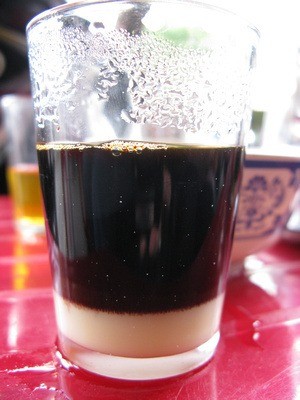
After drinking too much instant coffee for my liking on the Trans-Manchurian, I was primed and ready for Vietnam food culture’s superstar: their legendary coffee – reputedly some of the best in the world.
Even the way it’s brewed is unique and charming – metal contraptions slowly filter the coffee into a glass which sits in a bowl of cool water (to prevent breakage I presume). And the finishing touch of a dollop of sweetened condensed milk for stirring through makes this thick delicious velvety coffee to die for. But you won’t die at the cost; at a street vendor it will run you about 7,000 Vietnamese Dong (35 cents).
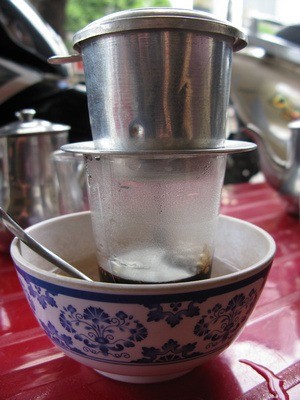
Even without “milk”, the coffee is strong, somewhat sweet, and inexplicably chocolaty. I bought some Vietnamese coffee and a little coffee filter to take onwards to Grenada, and although it’s a close replication it’s not quite the same. Not surprisingly, there’s an ingredient or technique I missed along the way. Maybe the secret is in the ambiance; siting on a miniature chair on the sidewalk, watching a river of bikes go past as you sip your coffee in relative peace.
Vietnamese Street Food Delights
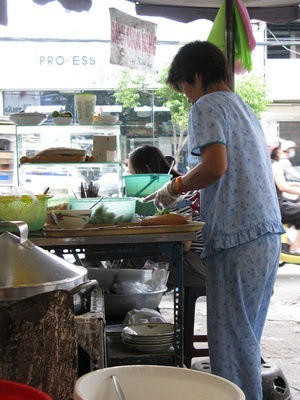
You don’t have to walk far on Saigon’s uneven chaotic bike-strewn sidewalks before encountering a street food vendor. Depending on the time of day, the items on offer vary, from soups to rice and fish/meat/veggies, to noodles, to sweets, corn, steamed buns, BBQ, coffee, drinks – you name it.
In my experience, the best places to get street food were the alleyways. Dart down a nondescript alley, and a host of impromptu restaurants and vendors reveal themselves. Treat yourself to the many delights within. Ignore the confused looks of many locals, who assume you’re lost. I had some of the funniest charade-based “lessons” on how to order and eat food in these places!
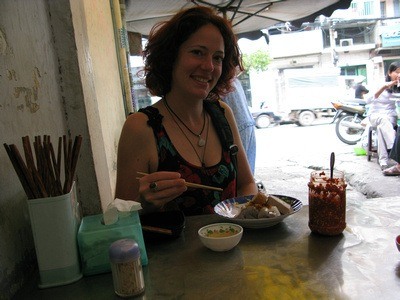
The most I ever paid for a street food meal was 35,000 dong ($1.70) for a delicious shrimp and squid veggie stir-fry served on a bed of flat rice noodles.
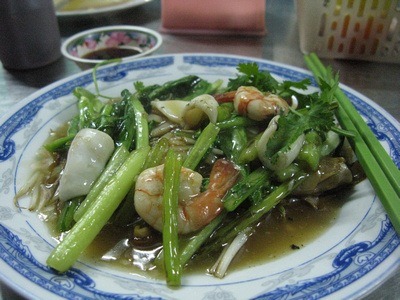
The best meal (I went back four times) was a breakfast of rice noodle crepes filled with vegetables and meat, topped off with bean sprouts, herbs, roasted garlic, and a sweet/spicy fish sauce you pour over the whole thing.
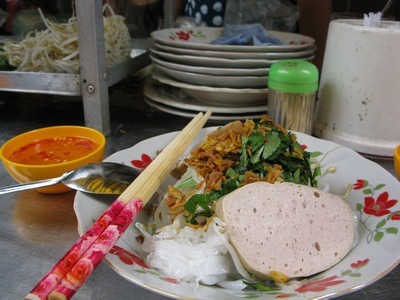
Vietnam Street Food Culture
An expat friend of mine cites Vietnam’s street food scene as intrinsic to their culture. “I love the fact that somebody who makes a good soup can open up a stall on the street corner and sell it to anybody passing by. It’s so enterprising,” he says. He hopes that it never gets formally regulated, going the way of Singapore’s organized hawker stalls (which resemble food courts).
Shopping at Markets
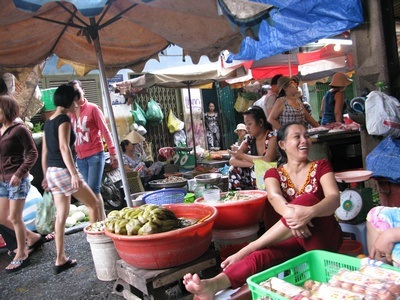
Almost immediately on arrival to Vietnam, I broke my golden rule of eating fruit and vegetables in developing countries: If you can’t boil it or peel it, don’t eat it! Instead, I (at first nervously, and eventually with abandon) found myself eating all manner of fresh food, drinking water (though reputedly not tap water), and even ice (which again, is apparently purified).
See also: Dealing With Parasites – A Guide to Clean Water Around the World
I’m still here and I didn’t have one bout of intestinal distress; so I figure it all went okay.
But shopping at a local market the day before I left made me think hard about everything I’d ingested in the week and a half prior.
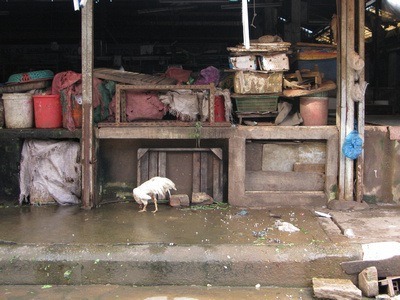
Fish was sold out of plastic bowls on the ground, where they were kept alive in water. I watched an eel make a slippery escape and slither along the muddy pavement we were walking on before being caught, gutted, and chucked in a plastic bag for a customer – right there on the pavement.
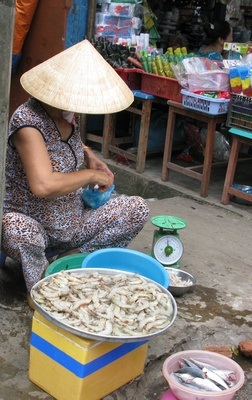
Although much of the fish was kept on ice, meat apparently didn’t need the same attention to refrigeration. Instead freshly plucked chickens sat next to live ones out in the heat, waiting for a customer to come along so the vendor could butcher it – again right on the pavement.
I reconsidered all those fresh veggies I had, veggies that were sitting in what my North American background would suggest was the “filth” of this local market. I tried to convince myself that the food I’d eaten in stalls and restaurants was different, but I knew it all came from the same place – bustling outdoor markets like this one.
My constitution was further challenged when the local friends I was shopping with then prepared all this food (2 kinds of meat, 3 kinds of fish, and veggie skewers galore) for a BBQ event. But the food that was served bore no resemblance to what I had seen in the market that morning. It looked straight out of a magazine (the friend in question was a chef), and I forgot about what I had seen that morning in relishing one of the best meals I had in Vietnam.
I realized that North American culture has sterilized everything beyond reprieve. Many of us grow up with the concept that meat comes from styrofoam packages in the chilled aisle of a grocery store – not a farm full of animals. Produce is highly polished or waxed and balanced in pretty pyramids. What would we do if the supermarket started butchering live animals right in front of us? Arguably we should pay a premium for it, since it would be fresher than anything we normally get. But instead we’d likely be horrified, so it’s not done. So we eat meat that is days if not weeks (even months?) old.
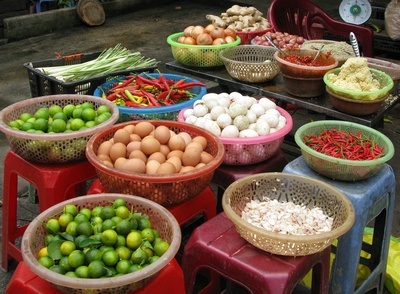
In Vietnam, food – in every sense – is much more basic. Unapologetically honest, cooked and served with different “hygienic” standards entirely. But more people in the world live and eat like this than the sterilized supermarket cultures of western society do. Even in Europe, I’ve been to outdoor markets selling freshly caught/butchered/made fish, meat, and cheese – which has been sitting in the sun in 30+ degrees.
This lesson in food culture was quite enlightening, and gave me a deeper respect for the food I eat – everywhere in the world.
Other articles about the quirks and eccentricities of Saigon that you might be interested in:
How to Cross the Street in Saigon – and other Bike-Centric Observations
And some later adventures in Vietnam, eight years later:

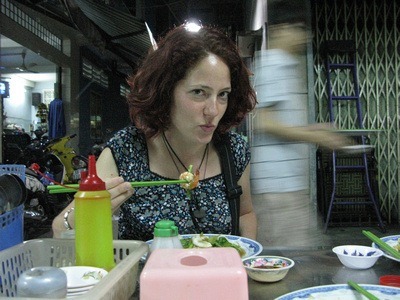

Nora, we also loved Vietnam. I too loved the coffee, my wife wasn’t crazy about the sweetened condensed milk though. My favorite city was Hanoi…more motorcycles than I’ve ever seen and a maze of a city.
@Shawn – I only had a day in Hanoi, but I really like the flavour there. I think it’s probably similar to Saigon, except a bit smaller.
And the sweetened condensed milk – much to my chagrin – has now become a part of my daily coffee routine. (I’m formerly used to black coffee, or with a bit of milk, so this is quite the shift for me).
A super superb post….as usual. I have travelled in the Far east for almost 20 years and street food turned me totally off Asian food. Foe instance I cannot stomach Korean food even for free. The smells turn me off.
@Baron’s – Really? But street food in Asia is usually the same stuff they serve in restaurants too. Did you have a bad experience?
Yes I did, this one time in Korea, we were travelling and I was extremely hungry (Ravenous) and we stopped at a hawker to grab a bite to eat…food was good but as we were eating I saw a women squatting down and washing rice in a filthy pan on the floor next to water running from a hydron making a pile of mud just next to the pan and this is what we were eating, not to mention the rat that was running in the alley who seemed to be well fed….have had the Delhi runs for a couple of weeks…very unconfortable situation to be in…having said all that I still agree with your article as we’ve had some very good, in fact excellent, street food in other places like Singapore, JB, KL and Penang….but generally speaking, and I know one shouldn’t generalize, I am off ASIAN food…I can’t stand it.
@Baron’s – In my experience, if I’m sick after eating something (even if the illness isn’t related to what I ate), I have trouble eating that food again. I understand!
I`m from Italy and absolutely loved this article! 😉 so true!
During my first trip to southeast Asia I started with a lot of hygiene related doubts but the smell from the stalls was so inviting I gave up on my third day, and the only stomach aches I had in six months there have been caused by my one and only Burger King meal!!
Ha ha – That’s so true, Claudia! I know many travelers who have gotten more sick at fast food joints than they have eating local street food! 🙂
“Maybe the secret is in the ambiance; siting on a miniature chair on the sidewalk, watching a river of bikes go past as you sip your coffee in relative peace.” spot on.
Vietnam made me a coffee convert. i don’t drink coffee prior to travelling there.
i brought home coffee and a coffee filter. i tried using condensed milk with it too but it did not taste close to what i had in the streets of Hanoi. but, still, absolutely better than those being served in fancy coffeeshops.
Hi Ayan,
I’m glad you had a similar experience with the coffee in Vietnam!
The reason the coffee didn’t taste the same even when using the filter and sweetened condensed milk is the coffee itself. I had the good fortune to get some coffee as well, but as soon as it ran out I noticed a big difference. It’s almost like Vietnamese coffee is chocolately, or velvety, or something! Yum! (drooling)
I really love your blog! It’s more like a personal diary with deep reflections than a traveling tips website 🙂 And I must say that your thoughts on food hygiene in Vietnam vs. North America are really interesting. As a Vietnamese who also has the luck to study in the U.S. for 4 years, I have experienced both kinds of food. Ironically, since I came back here I only go to supermarket to shop for food, mostly because it’s more convenient. But food safety in Vietnam is such a controversial issue, where it is indeed fresher, but no one knows where the food exactly came from, and what the animals actually eat before they were butchered. So I just prefer to shop where I can see exactly where the food comes from, and what company is responsible for that, although I can never be guaranteed 100%.
However, I still give life benefit of doubts, because street food in Vietnam is just so hard to resist 🙂 if you ever come back, I suggest you these must-try dishes: https://blog.inspitrip.com/578/7-delicious-traditional-vietnamese-foods-you-must-try/. If you want I can recommend some trustworthy places to eat them. Of course, I can never guarantee you 100% safety, so bring some medicine in advance – I know you haven’t had any intestinal distress, but you never know.
Cheers!
Hey Alex,
Since writing this article I’ve been to even more countries with similar markets, including many in South America where I’ve spent the last few years. I’m much less “freaked out” by the market conditions and love to shop there, but admittedly I prefer to cook vegetarian food at home and thus don’t deal with the meat/fish side of things.
Nice list of foods! It’s all about the Bun Cha, baby. 😉